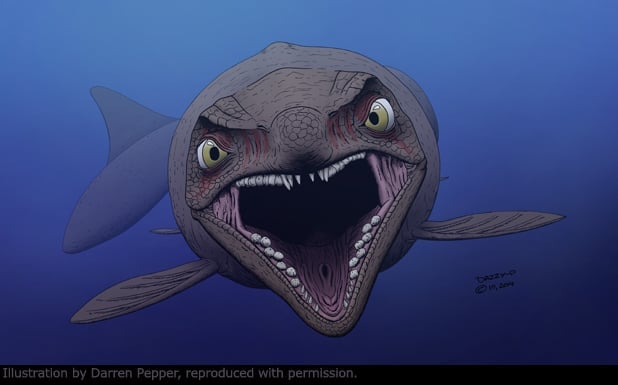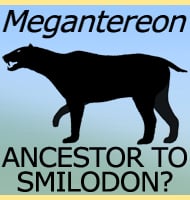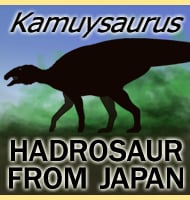In Depth
Although Globidens was not the only mosasaur to adapt to a diet of almost exclusively hard shelled animals, it does display perhaps the most specialised teeth. Rather than the sharp conical teeth seen in other mosasaurs such as Tylosaurus and Taniwhasaurus, Globidens had rounded teeth that had a ‘globe shaped’ upper portion of the crown that sat upon a slightly narrower base. An important aspect of the teeth being semispherical rather than conical is that they were much more resilient to impact damage such as chips and cracks. This meant that every time the jaw was moved up and down, each tooth would strike the shell of the prey animal like a ball hammer, cracking up the shell so that Globidens could get at the soft flesh within. Fossil evidence from Prognathodon, a mosasaur with a seemingly similar prey preference proves that turtles and ammonites were readily available as prey. The teeth and strong jaw of Globidens would have allowed it to tackle potentially tougher and more heavily armoured prey than even the larger Prognathodon could handle.
The exact reason why Globidens and other mosasaurs focused more upon shelled animals remains uncertain. It could have been that traditional food sources began to decline resulting in mosasaurs diversifying to reduce the stress of competition between each other for exactly the same food sources. It may of course have been something simpler such as filling an ecological void to take advantage of another food source. Whatever the precise reason, it was a successful adaptation with mosasaurs like Globidens and Prognathodon having broad geological ranges, and a reign that was only cut short by the Cretaceous-Palaeogene extinction.
One former species of Globidens, G. aegyptiacus has now been re-described as a distinct genus called Igdamanosaurus.
Further Reading
– A new mosasauroid reptile from the Cretaceous of Alabama. – Proceedings of the United States National Museum 41(1870):479-484. – C. W. Gilmore – 1912. – A new species of Globidens from South Dakota, and a review of the globidentine mosasaurs. – Fieldiana Geology 33(13):235-256. – D. A. Russel – 1975. – Durophagous Mosasauridae (Squamata) from the Upper Cretaceous phosphates of Morocco, with description of a new species of Globidens. – Netherlands Journal of Geosciences – Geologie en Mijnbouw 84(3):167-175. – N. Bardet, X. Pereda Suberbiola, M. Iaroch�ne, M. Amalik & B. Bouya – 2005. – A new species of the durophagous mosasaur Globidens (Squamata: Mosasauridae) from the Late Cretaceous Pierre Shale Group of central South Dakota, USA. – Geological Society of America Special Paper 427:177-198. – J. E. Martin – 2007. – Stomach contents of Globidens, a shell-crushing mosasaur (Squamata), from the Late Cretaceous Pierre Shale Group, Big Bend area of the Missouri River, central South Dakota. – Geological Society of America Special Papers, 427:167-176. – – The North African Mosasaur Globidens phosphaticus from the Maastrichtian of Angola. – Historical Biology. 22 (1–3): 175–185. – Michael J. Polcun, Louis L. Jacobs, Anne S. Schulp & Oct�vio Mateus – 2010. J. E. Martin & J. E. Fox – 2007. – Globidens(?) timorensis E. VON HUENE, 1935: not a durophagous mosasaur, but an enigmatic Triassic ichthyosaur. – Neues Jahrbuch f�r Geologie und Pal�ontologie – Abhandlungen. 293 (1): 107–116. – Eric W.A. Mulder & John W.M. Jagt – 2019. – Insights into the anatomy and functional morphology of durophagous mosasaurines (Squamata: Mosasauridae) from a new species of Globidens from Morocco. – Zoological Journal of the Linnean Society. – Aaron LeBlanc, Sydney Mohr & Michael Caldwell – 2019.











